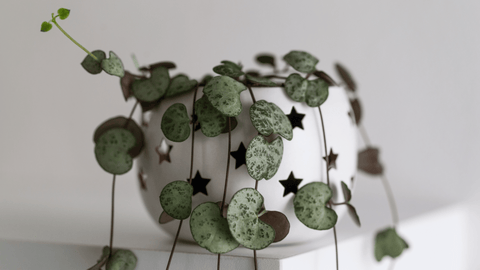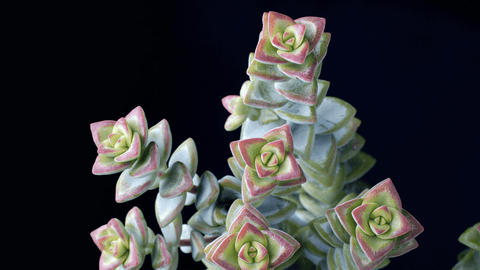
Spring into Style with These Stunning String Succulents
String succulents have become increasingly popular in recent years and are a favourite among succulent lovers and home decorators for their unique and delicate forms.
String succulents are characterized by their trailing or cascading stems and are members of different genera such as Senecio, Ceropegia, Crassula, Dischidia among others. They are known for their small, delicate leaves and unique growth patterns, which makes them ideal for hanging baskets, wall planters, and terrariums. They are drought-tolerant and super easy to care for. They thrive in a variety of lighting conditions, making them a great choice for indoor gardening.
The most popular string succulents for your home and how to care for them
Here are 8 among the most popular string succulents to bring into your home.
String of Pearls
The String of Pearls is technically known as Senecio rowleyanus. It has round, bead-like leaves along its thin, delicate stems. The leaves are usually about 1/4 inch in diameter and are a silvery-green color with a slightly glossy finish. It’ll produce small flowers that are not showy but have a sweet and spicy, cinnamon-like scent.
String of Pearls is a slow-growing plant, and prefers bright, indirect light and well-draining soil. It can survive long periods without water and should be allowed to mostly dry out between watering. Senecio rowleyanus is low maintenance, making it a perfect choice for people who don't have a lot of time to care for plants!
String of Hearts

The String of Hearts is technically known as Ceropegia woodii. With its dainty little silvery green hearts, this little plant is hard to find, making it very special for those who own one!
The easy-care string of hearts prefers bright, indirect light and well-draining soil, but can tolerate low light conditions. It is drought-tolerant, and can survive long periods without water. It should be allowed to dry out between watering.
String of Dolphins
This easy-care succulent is technically known as senecio peregrinus. The String of dolphins is a rare variety of trailing succulent that looks like a pod of dolphins. This is the kind of plant that will make you love succulents instantly!
String of Dolphins prefer bright, indirect light and well-draining soil. Like most string succulents, it is drought-tolerant and can survive long periods without water. Allow it to dry out between watering.
String of Turtles

String of Turtles is a popular semi-succulent plant for indoor hanging baskets and terrariums. This little cutie, technically known as peperomia prostrata, will have you instantly obsessed! Its leaves are usually about ½ inch wide and look like tiny turtle shells.
An easy plant to grow, String of Turtles can be adapted to a range of growing conditions. Peperomia prostrata prefers bright, indirect light and well-draining soil, but can tolerate low light conditions. It is drought-tolerant so don’t water it too much and allow it to dry out between watering.
Crassula Marnieriana

Crassula marnieriana has a fascinating structure that makes it stand out from any plant collection. It'll grow many thin stems lined with geometric, succulent leaves. It becomes an impressive, eye-catching plant with age. This easy-care crassula is also known as Worm Plant and Jade Necklace.
Crassula marnieriana produces small, star-shaped flowers that bloom in clusters on thin stalks. The flowers are usually pink or white in color.
The super-easy crassula marnieriana is drought-tolerant, prefers well-draining soil and should be in a location that receives full sun to partial shade. But keep it away from your pets and babies because if ingested, they’ll get a pretty bad tummy-ache!
String of Buttons

String of buttons is technically known as crassula perforata and has round, fleshy button-like leaves that are arranged in a spiral pattern on thin stems. The leaves are typically green, but can be tinged with red or purple when exposed to lots of sun. Crassula perforata will produce small, white flowers that bloom in clusters on thin stalks.
Like the crassula marnieriana, string of buttons is drought-tolerant and likes lots of sun. It too is toxic so keep it away from pets and children.
String of Tears
Senecio herreianus, also known as the String of Tears, is an eccentric little succulent with intriguing, trailing stems of oval, bead-like leaves that look like tear drops. Flowers appear on tall, slender stems as small, white fuzzy daisies.
Once acclimatized to its environment, this little plant loves bright light and a sip of water when the soil is dry to the touch – give it a little bit more during the summer months.
String of Watermelons
String of watermelons is technically curio herreanus and formerly was also referred to as senecio herreanus. It can be found growing in the wild along the banks of the Amazon River. String of watermelons is prized for its brightly colored and textured leaves in the form of tiny watermelons. The leaves can be green, pink, orange, or red and are often marked with white stripes.
As with most strings, give it bright light, well-draining soil and water when the soil is dry to the touch.
General Care for String Succulents
Sun
String succulents can do OK in normal lighting conditions, but they generally prefer bright, indirect light. Too much direct sunlight can cause the leaves to wilt and turn yellow, so it's best to place them in an area where they will receive bright light but not direct sun. In the wild, these plants often grow under the canopy of taller plants or on rocky outcroppings where they receive bright but filtered sunlight.
A south or west-facing window is ideal. If you don't have a window that receives bright, indirect light, you can also use artificial lighting, such as grow lights, to provide the light they need.
It's important to note that too little light can also be a problem. If your string succulents are not getting enough light, they will grow more slowly, and their leaves will become smaller. Lack of light can cause the stems to stretch and become leggy.
Soil
String succulents, like other succulent plants, require well-draining soil that allows water to flow through quickly and doesn't retain moisture for too long. A soil mix that is too dense or holds too much moisture can lead to root rot and other problems for your string succulent.
You can use standard cactus and succulent soil. This type of soil mix is specially formulated to provide the quick drainage and aeration that succulent plants need. It usually contains a mix of sand, perlite, and peat moss or coconut coir.
Be sure to avoid using regular potting soil, as it is too dense and can hold too much moisture for these types of plants.
Watering
String succulents don’t need much water. A good rule of thumb is to wait until the soil is completely dry before watering, and then to water thoroughly, but not to the point of saturation. When watering, it's important to avoid getting water on the leaves as this can cause rot.
Fertilizing is not necessary, but if you want to, you can use a balanced, water-soluble fertilizer at half strength every 4-6 weeks during the growing season.
Be mindful of the length of the trailing stems, as they can get very long and may need to be trimmed to prevent them from becoming too heavy and breaking.
Conclusion
String succulents are a must-have for anyone looking to add a touch of greenery to their house or apartment. These unique plants boast long, trailing stems that drape elegantly from shelves, windowsills, and hanging baskets, making them the perfect choice for those with limited space. Not only do they add a pop of color and texture to your home decor, but they are also low-maintenance and require very little attention. Plus, they are a great way to bring the outdoors inside, helping to improve air quality and reduce stress levels. With their stunning appearance and easy-care nature, string succulents are a must-have for any plant-lover.
